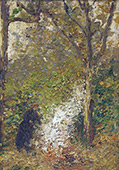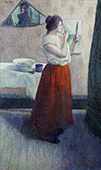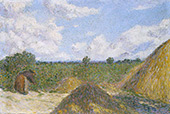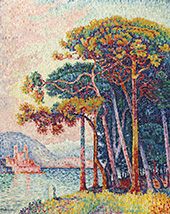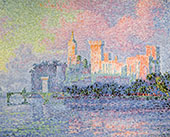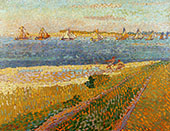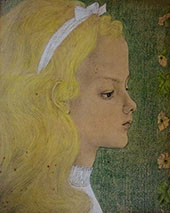Pointillism Oil Painting Reproductions
Find Pointillism oil painting replicas by Pointillism artists
Pointillism Painting: A Brief Introduction
Pointillism painting is a style of art where artists apply dots of color to their canvas. While this looks like a mismatched series of spots and dabs up close, it gradually merges into an image as the viewer steps away. The Neo Impressionists Georges Seurat and Paul Signac developed this innovative technique. Their theory focuses on color separation by using it to create stunning optical effects. Georges Seurat paintings and Paul Signac art is often described as Divisionism. However, Art Historians use the terms Pointillism and Divisionism interchangeably.
From Paul Signac paintings to Georges Seurat A Sunday on La Grande Jatte, this brief introduction presents the most famous Pointillism artists and their famous oil paintings.
What does Pointillism Art mean?
Pointillism painting refers to art using small dots or strokes of paint to create colorful wall art. When viewed from a distance, these dots and dashes blend to form a beautifully shifting yet balanced whole. Pointillist art is a response to Impressionist oil painting. While famous paintings by French artists Claude Monet and Pierre Renoir focus on fleeting moments and shifting light, Pointillism employs carefully controlled color combinations and marks. Nonetheless, there are similarities between Impressionist paintings and the Pointillist art movement.
Impressionist paintings often use tiny, fleeting brush marks with brushstrokes resembling the Pointillist technique of using dabs of color. Equally, artists in both movements depict urban scenes and the effects of light and color. For this reason, coastal locations, filled with sparkling water and shifting winds, are typical for Impressionists and Pointillist artists. At the final 1886 Impressionist exhibition, Camille Pissarro encouraged several young artists to participate. These artists included Georges Seurat, Paul Signac, and his son Lucien Pissarro. Their paintings appeared in separate rooms, highlighting divisions between the old and the new. Their oil paintings marked a distinct shift from Impressionism, and gone were spontaneous and emotional representations. Instead, this new art was scientific and systematic. Modern Art oil paintings showed shimmering scenes of contemporary life, alive with tiny dabs of color and light.
What are the defining principles of Pointillism Artists?
The color theories of Michel Eugene Chevreul profoundly influenced the principles of Pointillism. Chevreul worked for a tapestry manufacturer, trying to increase the vibrancy of their textiles. As part of this work, he discovered that placing complementary colors, such as blue and orange, in opposition enhanced the brightness and intensity. This discovery informed Chevreul’s ideas about simultaneous contrasts and how our eye naturally blends adjacent complementary colors. He published these theories in an 1839 book. These theories fascinated Georges Seurat in particular. As a result, they formed the guiding principles of Pointillism painting, resulting in colorful paintings which are enjoyed today.
Georges Seurat met the painter Paul Signac in 1884. Soon after their first meeting, the two artists put Chevreul’s theories into practice. Both Signac and Seurat also explored further investigations into color theory, notably the work of American physicist Ogden Rood.
What are the rules of Pointillism Painting?
The rules of Pointillism stem from Signac and Seurat’s interest in the principles of color theory. As a result, Pointillism involved the careful placement of dots of pure, unmixed pigments. For Pointillist artists, this created a more striking image than traditional methods of mixing colors. Despite their fame and importance, neither Paul Signac nor Georges Seurat described themselves as Pointillists. Instead, they preferred “Chromoluminarism” or “Divisionism.” Indeed, Paul Signac once commented that he didn’t “paint with dots”; instead, he said, a Neo-Impressionist artist “divides.”
Nonetheless, art critics soon adopted the term Pointillism, with the French art critic Felix Feneon particularly championing this new French art style. In one article, Feneon described Signac and Seurat’s art as “peinture au point”. Translating as “painting by dots,” this description captured the public imagination, and the term Pointillism stuck.
Paul Signac created a Portrait of Felix Feneon in 1890, confirming Feneon’s importance as a Pointillist patron and the artist’s belief in Pointillist techniques.
Who are the Two Famous Pointillism Artists?
The two most famous artists of Pointillism are Georges Seurat and Paul Signac. These two artists brought scientific color theory to life. Some of the most celebrated Paul Signac paintings include The Pink Cloud Antibes 1916 and Setting Sun Sardine Fishing Adagio Opus 221 1891. While these oil on canvas paintings were created more than twenty-five years apart, they show Signac’s dedication to the Pointillism painting style. Pink Cloud Antibes shows the progression of paintings by Paul Signac. The delicately painted sky swirls and shifts above a beautifully calm sea with dabs of red, yellow, purple, and pink appearing in the cloud. These tones contrast with darker rectangular blue dabs in the summer sky.
The most famous painting by Georges Seurat, A Sunday on La Grande Jatte, represents the pinnacle of Seurat’s explorations into leisure and modern life. It is one of Seurat’s most ambitious creations, showing upper-class Parisians relaxing on the banks of the Seine. It is one of our most popular oil paintings. Indeed, in terms of scale and complexity, La Grande Jatte represents the high point of Pointillism art. Seurat’s devotion to dots of carefully considered color extends to the frame, painted in contrasting rust and orange tones, enhancing the luminosity of the sun-drenched scene. The Grande Jatte is a huge oil on canvas painting in its original form. We specialize in oversized wall art; every replica painting is available in large size options.
Other famous Georges Seurat Pointillism paintings include The Bathers at Asnieres 1884 and La Luzerne Saint-Denis 1884. This latter oil painting is a more subdued landscape, and while the colors appear serene at first, upon closer inspection, a riot of greens, yellows, reds, and blues emerges.
Why is Pointillism Art important?
Pointillism artists are influential as they show the links between science and art. It was a thoroughly modern approach to artistic experimentation. The scientific theories employed by Pointillism artists revolutionized painting. Even artworks by lesser-known Pointillist artists such as Henri Edmond Cross are instantly identifiable. Just take Henry Cross’s La Plage de Saint Clair, for example. For someone who has never discovered paintings by Henry Cross, this painting is a stunning illustration of Pointillism in practice.
Sadly, Georges Seurat died at the young age of 31. Despite this, he left an influential legacy. Alongside Signac, the two artists spread Pointillist, or Divisionist, art theory throughout Europe. Indeed, Italian artists particularly embraced Divisionism. This theory formed the basis of Italian Futurism. Other famous French artists such as Vincent van Gogh, Pablo Picasso, and Henri Matisse also took inspiration from Pointillism paintings. Inspired by Pointillist approaches to art, a celebration of light and color links these famous artists. Each painter and their respective art movements moved slightly closer to abstraction in art. The shift to modern abstraction was one of the most important developments in 20th century art.
Famous Pointillism Paintings: Replica Oil Paintings For Sale
If you love colorful paintings, discover our extensive collection of art reproductions on canvas. Enjoy colorful wall art by Henri Matisse, famous Paul Signac paintings, or oil painting reproductions of Georges Seurat A Sunday Afternoon on La Grande Jatte.
Cannot Find What You Are Looking For?
Reproduction Gallery Information
Customer Service
(Send Us A Message)
Tel: (503) 937 2010
Fax: (503) 937 2011

